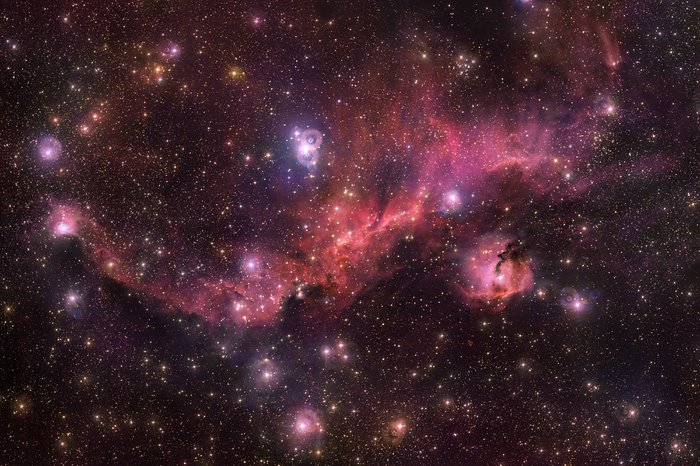The Rosy Glow of a Cosmic Seagull
Colourful and wispy Sharpless 2-296 forms the “wings” of an area of sky known as the Seagull Nebula — named for its resemblance to a gull in flight. This celestial bird contains a fascinating mix of intriguing astronomical objects. Glowing clouds weave amid dark dust lanes and bright stars. The Seagull Nebula — made up of dust, hydrogen, helium and traces of heavier elements — is the hot and energetic birthplace of new stars.
Credit:ESO/VPHAS+ team/N.J. Wright (Keele University)
About the Image
| Id: | eso1913a |
| Type: | Observation |
| Release date: | 7 August 2019, 12:00 |
| Related releases: | eso1913 |
| Size: | 20264 x 13488 px |
About the Object
| Name: | Seagull Nebula |
| Type: | Local Universe : Nebula : Appearance : Emission : H II Region |
| Distance: | 3500 light years |
| Constellation: | Monoceros |
| Category: | Nebulae |
Image Formats
Coordinates
| Position (RA): | 7 5 11.97 |
| Position (Dec): | -11° 6' 0.94" |
| Field of view: | 180.06 x 119.85 arcminutes |
| Orientation: | North is 90.1° right of vertical |
Colours & filters
| Band | Wavelength | Telescope |
|---|---|---|
| Optical u | 350 nm | VLT Survey Telescope OmegaCAM |
| Optical g | 480 nm | VLT Survey Telescope OmegaCAM |
| Optical r | 625 nm | VLT Survey Telescope OmegaCAM |
| Optical H-alpha | 659 nm | VLT Survey Telescope OmegaCAM |

